

November Issue 1999
With a Street Like This - You Could Have
a Cultural Center
A Look at Tryon Street, Charlotte, NC
by Jane Grau
In the not too distant past there wasn't much for tourists to tour in Charlotte. Okay, there were Hornets and Checkers games, but no geographical wonders like mountains, rivers, lakes or even parks. Except for expensive Blumenthal performances, no night life for anyone over 25 years old. No culinary experiences to write home about, no unique shopping venues. Except for the quasi-Bohemian NODA and the quasi-historical Fourth Ward, no eccentric neighborhoods or ethnic culture. No funky customs like watching the Cubs play from the roof of your apartment. And except for Discovery Place and the Mint Museum of Art, no interesting institutions -- no science or history museums, chocolate factories, great universities or libraries, architecture or monuments, world-renowned festivals, cemeteries, and so forth. Not even a funky mascot like Kansas City's giant bull.
About all Charlotte could boast of three years ago was being one of the prettiest and easiest cities in which to live (still is).
But now, NOW! there's Tryon Street. Bourbon, Veneto, Champs Elysee, Million Dollar Mile it ain't. But you can spend a whole day walking from one end to the other and come away feeling like you've absorbed some culture.
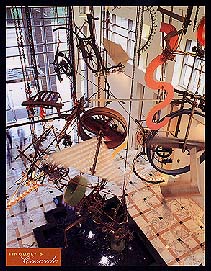 Jean
Tinguely *
Jean
Tinguely * 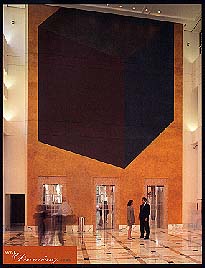 Sol
Lewitt
Sol
Lewitt
Interspersed with art and architecture are hot dog vendors and overpriced steak houses, traveling Broadway shows and rock clubs. On side streets are the Light Factory, the Museum of the New South and the Afro-American Cultural Center, The Great Aunt Stella Center, the bus barn and trolley tracks, Jean Tingueley's brilliant Cascade and a mural by Sol LeWitt at the Carillon, residential neighborhoods with churches and schools, a convention center, a funky parking deck, and on Saturday, a farmer's market -- all the things that make it a real center city. It won't be long before it will merge seamlessly with NODA, Wesley Heights, Wilmore, SouthEnd, Elizabeth, and Midwood.
A unanimous vote to move the Mint Museum of Art from Eastover to the Courthouse Building on Trade Street will establish once and for all where Charlotte's main cultural district is located.
Here's an arts-oriented overview of Charlotte's main street, circa 1999 (remember, it's a brand new city -- if you want antiquity, stay home):
First, a bow to Hugh McColl and his Big Bank for recognizing the economic and quality-of-life benefits of this revitalization. Without Bank of America's massive infusion of funds, downtown Charlotte would be a heartless worker-bee hive.
The Bank of America tower is itself a modern wonder. If you're on the highway, it's a Cinderella castle calling you home; at street level, its bulging granite facade is literally the hub of the urban experience.
Fresco artist Ben Long, who claims McColl as a patron, gives the place its class. His four classically rendered frescoes serve traditional religious and civic purposes. His first work, a dark but gentle interpretation of The Ascension at St. Peter's Catholic Church, was paid for with private funds. Then McColl commissioned the Tuscan-toned tryptich in the Bank of America Corporation Center lobby. A theatrical monument to the city's finest humanizes their headquarters on Trade Street and a dome at the Transamerica building that portrays McColl as a Renaissance cherub were both funded, in full or in part, by Bank of America.
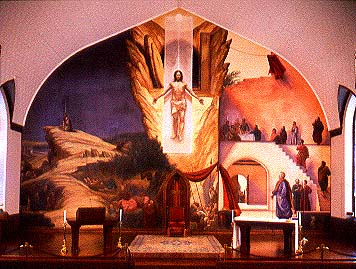 Fresco at St.
Peter's Catholic Church
Fresco at St.
Peter's Catholic Church
And finally, there are the Mint Museum of Craft + Design and the Tryon Center for Visual Art, both conceived by McColl and funded by Bank of America. The MMCD, the second-largest of its kind in the country, is housed behind a Beaux Art facade that was once the swankiest women's dress shop in town. The home of TCVA, which provides 3-month residencies for artists from all over the world, is a church whose burned-out shell blighted the cityscape for 15 years. No expense was spared in this beautiful renovation.
Start your walking tour on the south end of Tryon at the Panthers' Eriksson Stadium. High on the wall of Duke Energy is a kinetic light sculpture, Quadrille by Michael Hayden, reflecting "the action of our city and our company" in ever-changing patterns of light and color.
The stadium itself is a grand cartoon. It looks like Emperor Ming's castle in old Flash Gordon movies, a hint that the action inside shouldn't be taken too seriously. Giant, gleaming black panthers hover over each of the four gates. Their glowing green eyes and sleek, sharp claws make you feel like a six-year-old on the threshold of adventure. The building and its mascots temper football fanaticism even as they enliven the somber banking climate.
You'll be surprised to know they've mixed the sacred with the profane inside Eriksson Stadium. In the main lounge is some high art: four interpretive murals by Charlotte photographers Susan H. Page, Mark Fortenberry, John Hilarides, and Catherine Bauknight -- new slants on the old game, if you will -- that should have a subliminal aesthetic affect on the aforementioned fanatics.
As you walk north, you'll pass St. Peter's, with the Ben Long fresco, and the former Ratcliffe's Flower shop, now the Carpe Diem restaurant, one of the few pieces of distinctive architecture to be preserved amidst the modern development. Another landmark, the Latta Arcade, sits on the west side of Tryon. Its wrought iron balconies and glass ceiling are vestiges of a time gone by. Further north, on the same side of the street, is 212 S. Tryon, whose decades-old, walnut-and-marble interior is an enduring symbol of elegance.
At the Plaza, sculptor Dennis Smith arranged bronze figures of children to frolic in a water cascade that washes away workday stress (each statue has a different title).
Next are two sculptures perennially voted the Best and Worst, respectively, of Charlotte's Public Art. Pomodoro's Disco is a gorgeous brass abstraction that remains timeless in its appeal. Cluttering up the four corners of the square are bronze columns by Raymond Caskey that glorify the area's human and natural resources. The statues, which were commissioned by a well-meaning but ill-advised private committee, are clicheed in both style and concept.
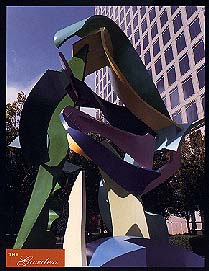 Jerry Peart*
Jerry Peart*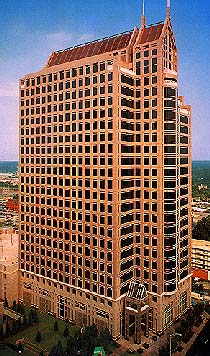 Carillon Building
Carillon Building
Across Tryon, in front of the Marriot City Center, is a soaring metal sculpture whose simple, slender form contrasts nicely with the chaos and solidity around it (title and artist's name not available). If you look west on Trade, you can see The Garden, a gaily furled ribbon of steel by Jerry Peart, next to the elegant Carillon building.
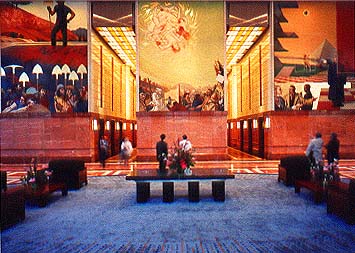 *
*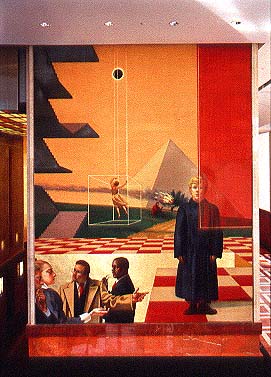
Ben Long's three frescos and a close-up of the right panel
After you gaze in wonder at Ben Long's fresco and admire the warmth and dignity of the Bank of America's red marble lobby, enter Founder's Hall, where you'll find Judy Rifka's fresh and exuberant ceiling mural adorning Bistro 100 and the folk art gallery By Hand, a nice contrast to the "uptown" art all around it.
The street-level detailing of several new buildings such as the Art Deco-y Interstate Johnson Lane make for some visual complexity, but the real magic lies three or four floors up. The view of Tryon from the balcony of the Mint Museum of Craft + Design is a very out-of-Charlotte experience, a wonderful Cubist composition of planes and angles.
Past the public library at 6th Street is Spirit Square for Arts and Education, a former church that is a superb example of "creative reuse." It was remodeled about 15 years ago as a cultural center housing a concert hall, two theaters, three art galleries, and art studios. Worth seeing is Performance Place, the church's sanctuary that was once the favorite venue of audiences and entertainers alike but which has been neglected by the Blumenthal Performing Arts Center, who manages it. McMillan Middleton, First Union, and Knight Galleries have rotating exhibits that are always provocative.
Near Spirit Square's 7th Street exit is Farvan International Gallery, an eclectic collection of artifacts from Africa and other exotic realms.
At 7th and Tryon is the Transamerica building, where Noel Gallery, featuring African American and South American art, adds sparkle and sophistication to street life. Through the archway is a Charlotte institution, the 18-year-old Hodges Taylor Gallery, where contemporary exhibits spill into the courtyard of 400 North Church behind it. With its fine print and photography galleries (the latter is the only commercial one in town) Hodges Taylor offers a comprehensive arts experience.
At the corner of the Odell building at 9th and Tryon is a satellite collection of contemporary paintings, crafts, and sculpture from the Joie Lassiter Gallery (located down 9th Street). In a courtyard at Odell is an uninspired sculpture of bears in trees (title and artist unavailable).
Finally, the stately steeple of Tryon Center for Visual Art rises like a queen's scepter at the north end of Tryon Street.
Between Eriksson Stadium and this serene beacon of aesthetism, you've sampled a delightfully diverse "palette" of what Charlotte has to offer in the way of visual art.
Jane Grau is a freelance writer living in Charlotte, NC. She has been a visual arts reviewer for "The Charlotte Observer", "Creative Loafing", and "The Arts Journal".
Information Index
Charlotte Visitor and Convention Bureau: 704/331-2700 or (http://www.charlottecvb.org).
Eriksson Stadium, 800 S. Mint St., is open to ticket holders during games. Call 704/358-7000 for information about group tours.
St. Peter's Catholic Church, 507 S. Tryon St. Fresco information: 704/358-0050. Donations welcome. Parking on 1st Street.
Bank of America Corporate Center lobby, 100 N. Tryon St. Hours: 7am-midnight everyday. Fresco information: 704/343-2693. Bank of America parking deck on College Street.
By Hand Gallery, Founder's Hall, 100 N. Tryon St., 704/343-0086. Hours: Mon.-Fri., 10am-6pm, Sat., 10am-4pm. Two hours free parking in Bank of America parking deck on College St.
Bistro 100, Founder's Hall, 100 N. Tryon St. 704/344-0515. Street parking, free parking with validated ticket in Bank of America parking deck on College Street, or free valet parking at Trade St. entrance.
Spirit Square Center for Arts and Education, 130 N. Tryon St., 704/333-4686. Gallery, Hours: Mon.-Fri., 11am-10pm. Free to the public. Parking in rear.
Farvan International Gallery, 119 E. 7th St., 704/375-1424. Hours: Tues.-Fri., 11am-6pm; Sat., 11am-4pm. Meter parking nearby and for-fee surface lot in front of gallery.
Hodges Taylor Gallery, Transamerica Building, 401 N. Tryon St., 334-3799. Hours: Tues.-Fri., 11am-6pm, Sat., 11am-3pm and by appt. Meter parking on street or free with validated ticket in Transamerica garage.
Noel Gallery, Transamerica Building, 401 N. Tryon, 704/343-0050. Hours: Tues-Fri. 11am-7pm, Sat., 11am-3pm. Meter parking or free with validated ticket in Transamerica garage.
Joie Lassiter Gallery, Odell building, 525 N. Tryon St. 704/373-1466. Hours: Wed-Fri., noon-5:30pm, Sat. 1:00-4:00 p.m. Meter parking on street or free with validated ticket at Palomino garage.
Tryon Center For Visual Art, 721 N. Tryon St.
Gallery information: 704/332-5535. Meter parking on street.
Mailing Address: Carolina Arts, P.O. Drawer
427, Bonneau, SC 29431
Telephone, Answering Machine and FAX: 843/825-3408
E-Mail: carolinart@aol.com
Subscriptions are available for $18 a year.
Carolina Arts
is published monthly by Shoestring
Publishing Company, a subsidiary of PSMG, Inc.
Copyright© 1999 by PSMG, Inc., which published Charleston
Arts from July 1987 - Dec. 1994 and South Carolina Arts
from Jan. 1995 - Dec. 1996. It also publishes Carolina Arts
Online, Copyright© 1999 by PSMG, Inc. All rights reserved
by PSMG, Inc. or by the authors of articles. Reproduction or use
without written permission is strictly prohibited. Carolina
Arts is available throughout North & South Carolina.